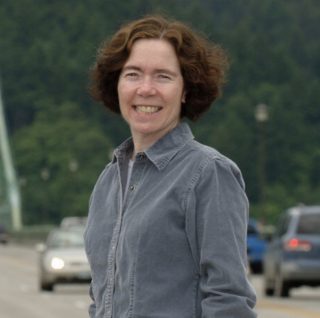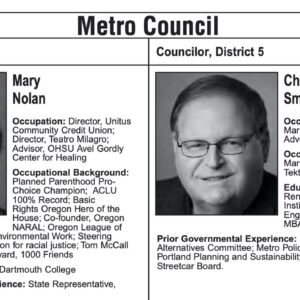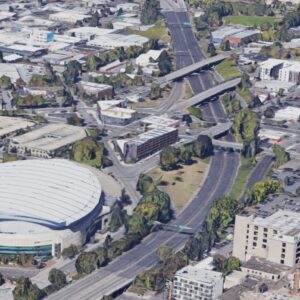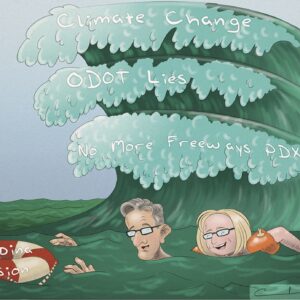“I trust ODOT to deliver the plan… They’ve made compromises. And I think we should move on.”
— Mary Nolan on I-5 Rose Quarter project (5/5/20)
There’s a heated race going on for the seat on Metro Council that represents District 5 — a district that encompasses a vast swath of Portland between our northwest border with Washington County, south to Highway 26 and I-84, and east to our border with Gresham near I-205.
“This was never a good project.”
— Chris Smith (9/9/20)
In the middle of that district is Interstate 5, which is ground zero for Portland’s fight against freeway expansions. The latest debate centers on the Rose Quarter and the Oregon Department of Transportation’s $800 million proposal to widen several miles of the freeway between I-84 and the Fremont Bridge.
The Metro Council race features two candidates — Chris Smith and Mary Nolan — that some people assume have relatively similar politics. But that’s not true on this issue. Or to be more precise, that hasn’t always been true.
Chris Smith has always opposed the expansion of freeways in urban Portland. He was an early voice against ODOT’s failed Columbia River Crossing project. And Smith has not only opposed the I-5 Rose Quarter project since the start, he’s the founder of No More Freeways, the scrappy group of activists that have successfully moved opposition to the project from fringe to mainstream.
Mary Nolan on the other hand, supported the Columbia River Crossing and was a recent supporter of the I-5 Rose Quarter project.
Advertisement
In early May at a debate hosted by City Club of Portland Nolan said she trusted ODOT to carry out their plan to widen I-5. Here’s her answer to a question about the project:
“I trust ODOT to deliver the plan. And I think this goes back to a question you asked us earlier about an instance where you have to compromise. And I think this is an example of very sophisticated, and yet humble, compromise. The original proposal from the ODOT engineers was truly appalling. But local leaders, including Metro President Lynn Peterson, the leaders of Albina Vision pushed back and asked for changes and they got them. They were satisfied that ODOT had heard the concerns of historic displacement of the black community, congestion, air pollution, and they got changes. And I support that effort. They’ve made compromises. And I think we should move on.”
Nolan’s trust of ODOT and willingness to “move on” with the Rose Quarter project came just weeks after the Oregon Transportation Commission (which acts largely as a rubber-stamp for ODOT) said it could move forward without a federal Environmental Impact Statement (EIS) despite demands for one from groups like Albina Vision, Portland Public Schools, and several top regional elected officials.
Three weeks after Nolan voiced support and trust of ODOT, OTC Vice Chair Alando Simpson donated $250 to her campaign.
Two months after Nolan’s statement at the debate, Albina Vision pulled their support of the project, saying, “We do not see our engagement resulting in meaningful changes to the project or its anticipated outcomes.”
Fast forward to September 9th and another debate between Nolan and Smith, this time hosted by the Democratic Party of Oregon Black Caucus (Facebook recording here).
Asked whether she supported the I-5 Rose Quarter project, here’s how Nolan replied:
“No. Because… I have actually reviewed this proposal and had different perspectives on it, depending on the content of the plan and the commitments that the planners — particularly at ODOT — made to Metro and more specifically to Rukaiyah Adams and the leaders of the Albina Vision project. When ODOT had agreed — or had said they would agree and it turns out that that unraveled — to make the changes around the design that both Metro on behalf of climate issues, and Albina Vision on behalf of historic black community concerns, I was willing to follow the lead of the those leaders of color. But now that ODOT has shown its true stripes, and essentially ignored its promises I think we have to recognize that that project is not going to remediate traffic. And it is going to actually worsen local pollution through that neighborhood and greenhouse gases that accelerate the deterioration of our climate.”
It’s unclear what “changes to the design” Nolan is referring to. ODOT has never offered to change major design elements of the project, especially to the freeway expansion part of the plan.
“I’m delighted that my opponent has joined the freeway fight… Welcome to the side of the angels, Mary,” Smith replied with a smile when he heard Nolan come out against the project. Smith then reminded viewers that he was the first public official to vote against the project way back in 2012.
“This was never a good project,” Smith added. “And I think ODOT’s stripes were on display for the entire period.”
— Jonathan Maus: (503) 706-8804, @jonathan_maus on Twitter and jonathan@bikeportland.org
— Get our headlines delivered to your inbox.
— Support this independent community media outlet with a one-time contribution or monthly subscription.








Thanks for reading.
BikePortland has served this community with independent community journalism since 2005. We rely on subscriptions from readers like you to survive. Your financial support is vital in keeping this valuable resource alive and well.
Please subscribe today to strengthen and expand our work.
This is truly illuminating, thank you Jonathan! This solidifies my vote for Chris.
For anyone not sold on Chris, check out his civic resume and the many committees he’s served on regarding transportation and land use planning (core functions of Metro) https://chrisformetro.com/meet-chris
In addition, he’s the one who inspired 3rd-party transit apps http://www.rosecitytransit.org/files/chrissmith.wmv
Mary isn’t bad, she’s just an average establishment politician
Three great statements of misplaced confidence;
1) Of course the U.S government will uphold all the treaties it has made with our
people.
2) I am confident the occupying troops will leave whenever we want them to.
3) I trust ODOT.
“…and east to our border with Gresham near I-205.”
Last I checked, Gresham isn’t even remotely near I-205 (96th) – it starts at 162nd and 175th.
Yet another member of the press who still has no idea where East Portland is, even after the city annexed it 30 years ago.
Of course NOT building more road and freeway capacity, pushes more cars to lesser streets and into neighborhoods. That is MORE DANGEROUS FOR BIKES.
I would think bike riders would love many more freeways to draw traffic off of the streets they use.
If we could close all the off-ramps and keep all the cars on the freeway then your statement would make sense.
All those cars have to exit the freeway at some point, and the more we put on the freeway the more we’ll have on our local surface streets.
The answer is to narrow or remove the freeways, forcing people to actually think about their transportation choices.
Yes, cars have to exit the freeway for the final part of their trip, but that is better for everyone than if they took neighborhood streets and arterials for THEIR WHOLE TRIP.
As to “narrow or remove the freeways”, that will just force more gridlock on the lesser streets AND MORE BIKE FATALITIES. As to forcing people to think about their transportation choices – they did and chose a fast, convenient and safe car. Bikes are much more dangerous than cars. As far as I can tell it is about 10x a dangerous.
Have you ever visited Vancouver BC? They have no freeways through the city, and are better for it. Cycling up there is safer than it is in Portland.
I don’t buy the 10x figure. The best statistics I was able to find, when I looked into this a few years ago, is that cars are about 3x safer on a per-mile basis. But even a per-mile comparison holds the problem that cars tend to be used for longer trips, and use of a car naturally leads to traveling greater distances. Access to a car certainly tends to increase your travel mileage by more than a factor of 3.
Another way of looking at it is that since the average speed of a car is 25mph, and the average speed of a bike is 8mph, on a per-hour basis they are about equivalent in safety. In other words, at any given moment in the transportation system, you are about equally likely to be killed or maimed whether you are on a bike or in a car.
If you look on a per-trip basis, bikes are actually safer. A typical bike trip involves less risk of death or debilitating injury than a typical car trip.
People perceive cars to be much safer than bikes, because they have so much steel and airbags around them. But people do not accurately perceive the danger of speed accurately. Sure, if they traveled at the same speed as bikes, cars would be vastly safer. But they don’t.
The goal of travel is to get somewhere, so one must compare per mile. Here is one credible calculation of the data:
Getting good data to calculate the bicycle fatality rate has been hard to find. While fatalities data is readily available, vehicle miles has been difficult to find. The Bike League published a report that contains bike miles traveled, allowing the calculation of bike fatalities on a per 100 million vehicle-miles basis to compare with automobile data.
Here are the data sources:
PDF Page 189 of https://bikeleague.org/sites/default/files/Benchmarking_Report-Sept_03_2019_Web.pdf
2017–Bikes: 8.5 Billion miles
USA bike fatalities (the number, not the rate)
https://en.wikipedia.org/wiki/Cyclist_fatality_rate_in_U.S._by_year
2017 – USA fatalities 777
USA Auto fatalitiy rate 2017 (the rate per 100 million miles traveled)
https://en.wikipedia.org/wiki/Motor_vehicle_fatality_rate_in_U.S._by_year
2017–1.16/100e6 (1e8)vehicle-miles
Calculate bike fatalities/100 million (1e8) vehicle miles:
777 fatalities/8.5e9 miles x 1/8.5 = 91.4 /1e9 = 9.1/1e8
Calculate the ratio: Bikes have a fatality rate 7.85 times that of cars. (9.1/1.16 = 7.85)
Since cars average more that one occupant, we can adjust vehicle miles to passenger-miles which is really people-miles of travel which is probably a better comparison. This calculation depends on the average number of people in a car and various numbers are published. We use 1.3 people per car as a conservative average:
7.85 x 1.3 = 10.2, thus traveling by bike is about 10 times as likely to kill you as traveling by car.
Note: There is some confusion about the meaning of rate. It is the result per exposure, in this case the deaths per mile traveled. To avoid tiny fractions, it is usually reported per many miles traveled, in this case per 100 million miles traveled.
I think you are overlooking the fact that the number one cause of Bicycle fatality is cars… so on a per mile basis how much more likely are you to kill someone accidentally in a car. I don’t have a number but I bet it is a lot. Also completely overlooked from this equation is the myriad of externalized costs of car travel from global climate change to the existence of oil-funded autocracies like Saudi Arabia. All of these need to be part of the equation because while you may be safer at the moment in a car if you die of lung cancer or your kid ends up killed fighting to support an oil oligarchy your life really isn’t that much better off in the long run.
“externalized costs of car travel from global climate change”
Have you ever seen any real evidence that man’s Co2 is causing dangerous global warming? If so, please share it.
“oil-funded autocracies like Saudi Arabia”
Of course we are now energy independent, so we no longer contribute to their funding. When the rest of the world finally gets on board with fracking (in spite of Putin’s best efforts), they will be wilting away.
There is lots of evidence and general scientific consensus on this issue. Do a quick google search and you’ll find plenty of reputable sources. The time for denial is over.
Duncan–“externalized costs of car travel from global climate change to the existence of oil-funded autocracies like Saudi Arabia. ”
Thanks to fracking, the USA is now energy independent and, hopefully, more countries will follow, leading to a collapse of those autocracies. But, right now USA driving does not support such places.
As to climate, have you ever seen actual evidence that man’s CO2 (only 5% of total Co2 emissions) is causing serious global warming? BTW, CO2 causes about 9-25% of warming total warming.
Sorry about the double posting, but I didn’t see it when I checked for replies for some reason.
OK, I buy your statistics (with the caveat we both agree on about data quality) on the rate per person-mile (and I’d not previously factored in the number of people in the vehicle).
But I stand by my assertion that per-mile rate isn’t a meaningful metric. A low-car or no-car lifestyle does not incur a 10x rate of danger (or even, necessarily, a greater danger at all) because it involves far fewer miles of travel, period.
It should also be noted – and this is where the earlier analysis I saw got to a per-mile rate more like 3x – that cyclist fatalities are disproportionately concentrated among people who are doing things like riding drunk, riding the wrong way on a one-way street, and riding at night without lights. Each of those activities by itself constitutes a majority of cyclist deaths; taken together, it accounts for the lion’s share, whereas those things account for fewer than half of vehicle-occupant deaths.
So in other words, if you stay sober, follow the rules of the road and use lights when you’re out at night, cycling isn’t as much more dangerous than driving than the overall fatality stats might lead one to believe.
But I get that it’s hard to get over wanting to feel like it’s so much safer than cycling when you’re surrounded by steel and airbags, nevermind the geometric effect of speed on danger.
Also worth considering the externalized fatalities brought up by Duncan.
$250 DOLLARS FROM the appointed Vice Chair of the Oregon Transport Committee? I mean that’s only slightly less then what the Oregon State Bike tax brought in.